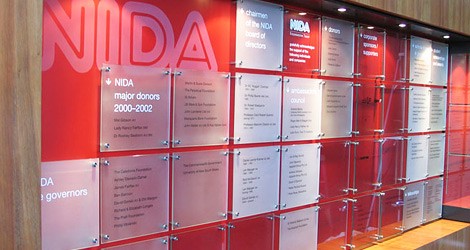This week, theatre types were treated to one of the industry’s favourite spectacles, as a power-play inside the National Institute of Dramatic Art’s board room went public.
The trigger was a long essay by former NIDA board member Chris Puplick, to be published in Currency House next month, which dumps all over NIDA’s current board and management, and alleges serious declines in educational standards at the national drama school.
Described by Puplick, a former Liberal senator, as “both an investigation and a protest”, the essay is a trenchant critique of the direction of the institute under current director Lynne Williams, and includes some very personal attacks on Williams herself.
“Her CV makes it clear that Williams has never directed a significant theatre performance; taught acting students; supervised theatre training or auditioned students for placement in a training institution or ever earned a living in the professional theatre,” he wrote, adding later that Williams is “a woman with no appropriate experience and with a Thatcherite style honed after a quarter of a century in the UK”.
“The appointment in 2008 of Lynne Williams to the position as director and chief executive of NIDA is one of the defining moments in the school’s history,” he argued, alleging that “the appointment, and her subsequent tenure, split the then board, and has led to the departure … of almost all the senior artistic staff”.
Puplick doesn’t hold back about current NIDA chairman Malcolm Long either, describing him as “a man whose record suggests more interest in structures than content” and, quoting ABC historian Ken Inglis approvingly, as “short on vitality”, with a “tendency to lecture”.
Strong stuff. After initially refusing to comment, NIDA hit back this week, releasing a statement from the board repudiating Puplick’s attack. “The board of NIDA completely rejects the attack on the institute,” it read, continuing:
“Mr Puplick is an apparently disaffected former board member. His paper is a biased essay, the foundations being riddled with errors compounded by the selective use of source material.
“Mr Puplick’s three years (2007-2010) on the NIDA board were marked by conflict with the overwhelming majority of members over many issues, including future directions for NIDA and appropriate levels of involvement for a board member in the day-to-day operations of the Institute.”
Later in the statement, the board reiterates that Lynne Williams “has the board’s complete support”. NIDA also went on a publicity campaign this week, trotting Williams out to The Sydney Morning Herald. “This morning at 11 as I walked in to talk to the assembly, everyone applauded,” she told Fairfax’s Andrew Taylor, which may not be the best way to lay to rest rumours of personal arrogance.
Who’s right? As ever, gossip swirls in arts circles, but Crikey could find no one willing to go on the record to either attack or defend NIDA under Williams. That might be telling in itself, given NIDA’s high profile. But it doesn’t seem as though there is a groundswell of dissatisfaction with the current direction of the institution. On one hand, NIDA graduates are still numerous on Australian screens and stages; on the other, given NIDA’s reputation and its generous funding levels, it’s not surprising that many of the most talented actors, directors and designers in the country go to the institute.
As even Puplick acknowledged, the latest audit of NIDA by the Australian Universities Quality Agency gave it a tick of approval. AUQA commends NIDA’s strategic plan and “human resource function”, and the recommendations it makes are not, on the whole, indicative of an institution that has run off the rails.
Whatever Puplick thinks, there’s no doubting the demand for places. Last year, NIDA received an astonishing 1834 applications for a first-year acting class that takes 24. Despite the dismal financial prospects of a life in the theatre, there appears to be no shortage of students desperate for a chance to strut their stuff.
Mind you, NIDA should be delivering high standards of teaching, considering the resources available to it. This column has examined the funding issues of creative training institutions several times, most recently in the context of tertiary music schools. As the government’s own Base Funding Review found, creative arts courses in universities are underfunded, especially given the demands of teaching difficult crafts such as instrumental musicianship or fine arts.
NIDA doesn’t have to worry about the Base Funding Review, because it is not funded through the federal Department of Education. Instead, it draws nearly all its grant funding from Simon Crean’s Arts portfolio. In 2011, it received $6.8 million in ongoing funding, plus $2.4 million in capital funding.
In 2011, NIDA enrolled only 169 students, a gross funding ratio of more than $40,000 per student. That’s nearly four times the federal funding per student that university drama courses receive. NIDA also pulls in millions in sponsorship and fund-raising revenue each year, largesse that struggling acting courses at regional universities could only dream of. Given that, NIDA better be operating at the very highest level. Anything less would be an unconscionable waste of taxpayers’ money.
To my mind, the real scandal here is that we’re talking about an elite, highly funded drama school like NIDA at all. At a time when most creative arts courses in the country have fallen on desperately hard times, NIDA enjoys gold-plated educational resources. The imbroglio distracts from the bigger problems facing the arts and humanities in our universities.
The real questions we should be asking are about what steps we can take to improve the graduate outcomes for students of the arts in less-famous institutions.









The gossip I here is that WAPAA has replaced NIDA as the place to go.
The high number of applications is probably due to so few places being available. If you get to select the best applicants from such a large pool it is not surprising if your graduates do well. It may have nothing to do with the school – it may just mean that people were good and were selected because they were good (this applies other places than at NIDA).
It sounds like there are some pretty personal issues in play.
It would be fun to know the personal background and stories. Unfortunately I don’t.
Seems patently contradictory to talk about the highly funded NIDA as a ‘waste of taxpayers’ money’, then to claim that as it is ‘gold-plated’ it’s not worthy of discussion.
Please note the Auqa review was done with the “old NIDA” staff. It is accredited on the plan of the staff that is no longer there. The course is at present under radical change, that has , probably, not had the same scrutiny as it had in 2010-2011. A certain percentage is able to be adapted per year, on application, I think. How different it is now is something that Auqa may need to ascertain. NIDA may be able to inform you.
This old Auqa submission ,then, is before what you call the “run -off-the -rails”, began. Although even then it was looming.
I am an old member of that staff that laboured to the Auqa strictures.
I am not privy to the number of applications for last year but the Acting Course only took in 20 places for 2012. 14 for Acting. 6 for Music Theatre. This is a decrease from the usual 24 – the first time ever! A fairly elitist number considering the applications. I understand that two of the first year Acting Course students have left -of their own volition. The first time ever! Now there are 18 students in the Acting Course. (One of the students that left was an Indigenous student.)
You claim you have not being able to find people to talk to. Maybe you have not really searched hard enough. Past staff and students may, at last, have some air to do so if asked. (Please understand that it is the Acting Course that has been under great duress. Other courses have benefited from the changes.)
I certainly have not been contacted. Ask the questions and I will try to reply.
What do you want to know?